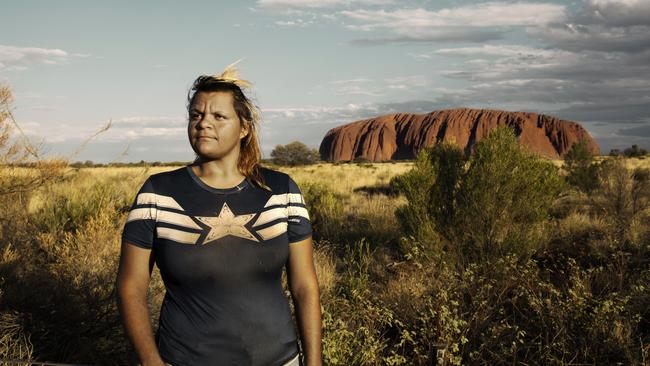Ascent and dissent of Uluru: opinion split by rock of ages
It’s the greatest show on earth and it’s been playing non-stop for 550 million years.

It’s the greatest show on Earth and it’s been playing non-stop for 550 million years: the summer sunset at Uluru when the lemon-butter light hits that big red rock and 200 slack-jawed global spectators thank their lucky stars for finding this place they call Australia.
The Weekend Australian caught this knockout rock show standing alongside two dead-set VIPs, Wanatjura Patterson, 25, and her wheelchair-bound great-grandmother, Napananga Nelly Patterson, 80, a local Anangu law woman and custodian of sacred Uluru tjukurpa stories that can sound as dark as the night and as illuminating as that dropping-dead heart sun.
The tourists had their champagne, blue cheese and Euro ciggies and Nelly Patterson had her memories. A five-year-old girl walking barefoot through spinifex past the monolith, the creation stories of elders filling her ears with the wonder of family, existence and how it’s possible to have a home without walls built of red sandstone rising 348m to the sky.
“Back in the olden times, my great-grandmother here kept this place very special,” said Wanatjura Patterson. “I grew up with her telling me stories about this rock every time we pass here … I feel alive out here. I can breathe. Every time I drive off from this place I cry. It pulls me.”
For half a century, Nelly Patterson has watched tourists from Australia and across the world climb to the Uluru summit, pulling themselves up on a chain embedded in the rock in 1966. On October 26, 2019, exactly 34 years after the government handed Uluru back to its traditional owners, that climb chain will come down, an act cutting to the heart of an ownership and belonging debate that remains unsettled for the thousands of Australians rushing to the central desert to climb Ayers Rock while they still can.
“It was now or never,” said Peter Chapman, 50, a cane farmer whose family of five had travelled from Bundaberg, Queensland, to climb the rock. “I think every Australian, every person in the world, should have an opportunity to climb the rock.”
Said Parisian traveller Nathan Cohen: “We came to Australia to do this. I know it will be forbidden in October next year. I had to see that view from up there.”
Marc Hendrickx, a Sydney geologist and the rallying voice behind the Right to Climb Ayers Rock movement, said: “Everyone who has climbed the rock has a story to tell. My connection is academic. I’m fascinated by the story of how the rock got there.”
Notions of ownership and modern politics on the rock, Mr Hendrickx said, are “an insult” to its age and grandeur. “Visitors should have the right to make up their own minds,” he said.
Wanatjura Patterson placed a gentle hand on her great-grandmother’s left shoulder as Uluru’s eternal rock show neared its climax.
“There’s a lot of stories around this rock,” she said. “There’s men’s areas and women’s areas and there’s animal dreaming. It’s very special. At the moment there’s all these people climbing over the rock. It’s disrespectful. It’s actually shameful. We keep asking them not to. There’s a sign there. I don’t know, maybe they can’t read or something. But they read it, I watch ’em. Maybe they don’t understand.”
“It’s my home,” said Nelly Patterson, waving her arm across the landscape. “Close it.”



